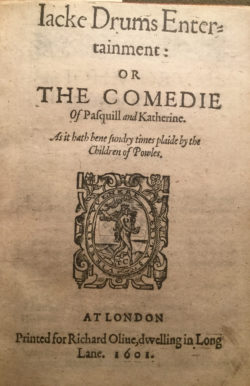<em>Jack Drum's Entertainment</em>
One of Marston’s earliest plays, Jack Drum’s Entertainment was performed in 1599 or 1600 by the Children of Paul’s. This makes it a competitor to Shakespeare’s later comedies – texts like As You Like It and Twelfth Night; and to the earliest plays of Jonson and Dekker. It seems to have been popular in its day, going through two (or possibly three) early quartos. And yet it has never had the attention of a scholarly editor. Even the early stages of collation are revealing some surprising variations between surviving printed copies.
Jack Drum’s Entertainment is a strange mixture of genres. On one level, it looks like the Jacobean city comedies that will follow later: at the centre of the plot are the two wealthy daughters of Sir Edward Fortune, who are sought as wives by handsome young men and odious old ones. Meanwhile a married man, determined to show off the moral purity of his wife to his friends, succeeds only in accidentally causing himself to be cuckolded. The cast of characters includes an unscrupulous usurer, immersed in the world of the city, and a foolish Frenchman. But other notes seem to come straight from the world of medieval romance. A young woman is disfigured in an acid attack, and her lover goes mad with grief. She is healed by the miraculous medication of a local hermit, and her reappearance saves her lover too. There are not one, but two, faked murders. The omnipresent drunken morris-dancers, including the eponymous Jack Drum, give the whole world of the play a strangely festive, pastoral feel.
Perhaps the key to this mixture of genres is to be found in the play’s liminal location. It is set mainly in the village of Highgate, at the top of a tall hill looking down over contemporary London. Indeed, it goes to some lengths to sketch in this precisely realized location in a way that almost anticipates the “place-realism” comedies that are generally associated with the 1630s. Marston’s play is about contemporary London, and yet seems to maintain a detachment from it at the same time, symbolized by the steep hill up which all the characters must climb to reach Highgate. One of the tasks of this edition will be to clarify the play’s use of location.
And then there is the question of the play’s involvement in contemporary theatrical controversy. For a long time it has been thought that the play was an elaborate roman a clef relating to contemporary theatre scene, with Jonson, for instance, caricatured as Brabant Senior. Few now endorse these ambitious identifications. And yet this is obviously a play much concerned with the contemporary theatre scene: the leading character is named Pasquil, and in a particularly metatheatrical moment, one of the characters embarks upon a disparaging description of the Children of Pauls. Its leading character, Pasquil, takes his name from a type of satire. Like, arguably, its contemporary As You Like It, this seems to be a play much concerned with the question of what the satirist’s charter is.
Without a professional production in more than 400 years, Jack Drum’s Entertainment was revived by The Young Actors Company in 2016. Sam Plumb’s team of young actors discovered a celebration of love, full of opportunities for clowning and music. This edition aims to find out more about that play.

